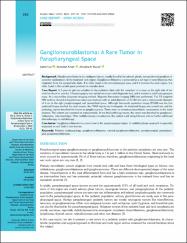| dc.contributor.author | Ulu, Şahin | |
| dc.contributor.author | Kınar, Abdullah | |
| dc.contributor.author | Bucak, Abdulkadir | |
| dc.date.accessioned | 2021-05-05T22:14:07Z | |
| dc.date.available | 2021-05-05T22:14:07Z | |
| dc.date.issued | 2020 | |
| dc.identifier.issn | 2149-2247 | |
| dc.identifier.issn | 2149-2549 | |
| dc.identifier.uri | https://doi.org/10.14744/etd.2020.69822 | |
| dc.identifier.uri | https://hdl.handle.net/20.500.12933/303 | |
| dc.description | Kinar, Abdullah/0000-0002-2968-4165 | en_US |
| dc.description | WOS:000558780600020 | en_US |
| dc.description.abstract | Background: Ganglioneuroblastoma is a malignant tumor, usually found in the adrenal glands, retroperitoneal ganglions or posterior mediastinum. In the head and neck region, Ganglioneuroblastoma is presented as a sub-type of neuroblastoma that originated from the sympathetic chain. It is often found in the retropharyngeal area, and if it involves the neck region, it is often found in the carotid space posterior to vascular sheat. Case Report: A 5-year-old girl was admitted to the pediatrics clinic with the complaint of a mass on the right side of her neck for about six months. Ultrasonography was carried out as an initial diagnostic tool, and it revealed a solid homogeneous mass. As a second-line diagnostic imaging method, Magnetic Resonance Imaging (MRI) was performed. The T2 weighted MRI sections showed a hyperintense mass was observed with an axial diameter of 37x40 mm and a craniocaudal diameter of 6 cm in the right parapharyngeal and prevertebral space. Although fine-needle aspiration biopsy (FNAB) was the first preferred biopsy method for neck masses, the FNAB report was inadequate. An incisional biopsy was carried out, and the pathology report described the tumor as ganglioneuroma. There were no immature/neuroblastic components in the serial sections. The patient was operated on transcervically. In the final pathology report, the tumor was described as ganglioneuroblastoma, intermixed type. After multidisciplinary consultations, the patient is still being followed with no further additional chemotherapy or radiotherapy. Conclusion: Ganglioneuroblastoma is a rare tumor in the parapharyngeal region. A multidisciplinary approach is especially important in such kind of rare tumors. | en_US |
| dc.language.iso | eng | en_US |
| dc.publisher | Erciyes Univ Sch Medicine | en_US |
| dc.rights | info:eu-repo/semantics/openAccess | en_US |
| dc.subject | Pediatric otolaryngology | en_US |
| dc.subject | ganglioneuroblastoma | en_US |
| dc.subject | cervical ganglioneuroblastoma | en_US |
| dc.subject | parapharyngeal | en_US |
| dc.subject | parapharyngeal ganglioneuroblastoma | en_US |
| dc.title | Ganglioneuroblastoma: A Rare Tumor in Parapharyngeal Space | en_US |
| dc.type | article | en_US |
| dc.department | AFSÜ, Tıp Fakültesi, Cerrahi Tıp Bilimleri Bölümü, Kulak Burun ve Boğaz Hastalıkları Ana Bilim Dalı | en_US |
| dc.contributor.institutionauthor | Ulu, Şahin | |
| dc.contributor.institutionauthor | Bucak, Abdulkadir | |
| dc.identifier.doi | 10.14744/etd.2020.69822 | |
| dc.identifier.volume | 42 | en_US |
| dc.identifier.issue | 3 | en_US |
| dc.identifier.startpage | 339 | en_US |
| dc.identifier.endpage | 342 | en_US |
| dc.relation.journal | Erciyes Medical Journal | en_US |
| dc.relation.publicationcategory | Makale - Uluslararası Hakemli Dergi - Kurum Öğretim Elemanı | en_US |
















